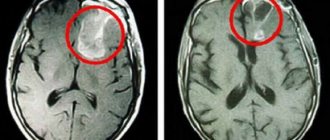tags:
Behavior, Addictive, Change, Form, Alcoholism, Condition, Reality, Problem LESSON 11.
The duration of the lesson is 4 hours.
The purpose of the lesson is to study the clinical manifestations of alcoholism. Learn to correctly formulate a diagnosis and carry out differential diagnostics. To become familiar with theoretical approaches to the problem of alcoholism, treatment and rehabilitation of patients suffering from alcoholism.
As a result of studying the topic, the student must
:
- have an idea
of the current state of the problem, the epidemiology of mental disorders associated with the use of psychoactive substances, the etiology, pathophysiological and biochemical basis of alcoholism - know
the general mechanisms of development of addictive behavior, classification of addictions, manifestations of mental and physical dependence when using psychoactive substances, clinical forms of alcoholic psychoses, basic principles of treatment of alcoholism and acute alcoholic psychoses, features of the examination, features of the manifestation of non-chemical addictions, methods of treatment and prevention. - be able
to identify symptoms of mental and physical dependence, diagnose acute and chronic alcoholic psychoses, formulate a diagnosis, relieve psychomotor agitation in alcoholic psychoses, provide emergency assistance for intoxication with psychoactive substances, and relieve withdrawal syndrome. - understand
the social significance of the problem of alcoholism, the importance of preventing addictive behavior, taking into account a single development mechanism for different forms of addiction.
At the beginning of the lesson, a test control of students' knowledge is carried out with further analysis of incorrect answers. A survey of students is conducted on the theoretical part of the lesson. Students' understanding of the prevalence of the disease, problems of etiology and pathogenesis, classification of addictions and alcoholism is revealed.
Particular attention is paid to the consideration of alcoholism from the point of view of the concept of addictive behavior. The classification of types of addictive behavior and forms of alcoholism is analyzed.
Meaning of the term and spread of the disease
The diagnosis of alcoholism officially appeared in 1952, although the name of the disease was given much earlier. In 1849, a doctor from Sweden formulated a precise definition of an illness in which a person drinks a lot of alcohol. The scientist noted that this disease is the cause of a whole complex of pathological changes in the functioning of the body.
From the point of view of psychiatry and physiology, alcoholism is the regular use of strong drinks, which occurs even despite the negative consequences of these actions. We are talking about the destruction of the individual and the defeat of the entire organism.
Back in the 19th century, experts came to the conclusion that the degree of alcoholization of the population was related to the standard of living of society. The richer the citizens of a country, the more they drink. This fact is confirmed by data from the National Statistical Committees. In developed countries, about 7 liters of alcoholic beverages are produced per capita, in developing countries - 14 liters.
Reports from the World Health Organization indicate that the number of alcohol addicts is growing every year. So in 2000, worldwide, there were 140 million registered alcoholics. Ten years later, the figure exceeded 208 million.
It is noteworthy that in the 80s of the last century, France and the United States of America led in the number of alcoholics. But a few years later, Japan and the CIS countries came forward.
Causes of alcoholism and its manifestations
After drinking alcohol, a person experiences a very pleasant feeling - euphoria. Together with it, the drinker is drawn to sleep, he is in a relaxed state, the pain decreases, and he becomes warmer. Many experts believe that it is for this reason that the craving for alcohol occurs.
There is an opinion that addiction is formed due to the special effect of alcohol on the human stomach and intestines. Ethanol does not allow this organ to absorb useful substances, but accelerates the acceptance of poisons. As you abuse alcohol, the content of toxins in the body increases. From this moment, alcohol begins to play the role of the only antibacterial and neuroblocking component. Thanks to ethanol, the patient feels better, and this is how addiction appears at the genetic and level.
The psychological craving for a bottle is explained by the influence of alcohol on hormonal levels. The body produces a special hormone of happiness - dopamine. When alcohol enters the bloodstream, this substance is released. The person experiences true bliss. However, friendship with the “green snake” leads to the fact that the body ceases to reproduce dopamine itself. To produce it, alcohol is now needed, and in a sober state the patient feels unhappy and falls into deep depression.
The occurrence of alcohol dependence is due to several factors:
- social prerequisites;
- biological reasons;
- psychological factors.
Important!
Alcoholization largely depends on the traditions and norms of behavior within a social group. For some peoples, alcohol was an integral part of religious rituals. To this day, it occupies a major place in organizing celebrations.
Very often the disease appears among socially vulnerable people. Thus, in the United States of America the largest number of alcoholics are among homosexuals. In the CIS countries, this disease more often affects single and unemployed citizens. Interesting statistics: male alcoholism occurs 3 times more often than female alcoholism.
Alcohol is a common problem
Intoxicated drinks are a problem not only of the population, but also of the state. Because of the craving for drinking, people lose their jobs and give up material and spiritual values. And the government is left without a workforce, as labor productivity decreases. The treasury is losing money to uncover crimes committed in alcohol intoxication, maintain sobering stations and treat alcoholics.
The problem of alcoholism in Russia is becoming more serious , and has long ceased to be a reason for jokes. This is precisely why anti-drinking campaigns are being carried out year after year and prices are rising. The state is trying with all its might to protect the residents of Russia from addiction.
Alcohol destroys brain cells and creates neural connections that are similar to those formed by smoking and drug addiction, so it is fundamentally wrong to say that wines, liqueurs and other alcohol-containing drinks are just food.
Stages of alcoholization
Addiction develops gradually. The timing of its formation is different for each person. Some people become addicted to drinking throughout their lives, while others fall into slavery within a couple of months. There are many explanations for this phenomenon. Firstly, these are the individual characteristics of the body. It is known that a man drinks himself more slowly than a woman. The age at which a person started drinking alcohol also plays a certain role. The intensity of addiction formation largely depends on the type of drinks. For example, beer is more addictive than vodka. However, attachment is formed unnoticed. A patient can drink malt every day for a year, but not experience a hangover and not consider himself an alcoholic. Vodka disease is pronounced. A person quickly gets drunk and goes on binges.
According to experts, alcohol dependence syndrome has 3 main stages.
The first stage is characterized by an unhealthy attraction to alcohol. There is no hangover at this phase. There is not yet a large accumulation of ethanol breakdown products that have not been eliminated in the body. Therefore, after drinking, a person feels relatively normal.
During the second stage, changes occur in a person’s appearance:
- swelling of the face appears;
- the skin becomes either very dry or pathologically oily;
- bags form under the eyes, the whites become yellow, the pupils narrow;
- in the nasal triangle you can clearly see the venous network.
Important!
The main sign of the second stage of alcoholism is the occurrence of binge drinking, which can last up to two weeks. The principle of its formation is very simple. A lot of broken down alcohol residues accumulate in the body. These substances cause poisoning, which can be relieved with a new dose of alcohol.
During withdrawal symptoms, the patient experiences:
- migraine;
- elevated temperature;
- trembling in the arms and legs;
- failure in the gastrointestinal tract;
- increased sweating;
- sleep disorders;
- dizziness.
The next 150 grams of “little white” provide relief, but not for long. As soon as the person sobers up, the unpleasant symptoms will return. A new dose of “medicine” will be needed.
Alcohol addiction in the second stage is characterized by changes in behavior. Usually during this period a person loses his family and job. There are disturbances in perception on the part of the brain. Delirium tremens often occur.
The third stage is characterized by memory deterioration or partial loss. An alcoholic may forget his address and last name. It’s normal to go to bed and leave the kettle on the stove. For this reason, fatal fires often occur.
Teenage alcoholism in Russia. Causal relationship
The worst effect alcohol has on children. The Ministry of Health says that at least 25% of minors under the age of 15 drink alcohol 5-6 times a week, which is double the number 30 years ago.
Adolescence is the most important stage of personality development. Some children realize themselves in promoting their talents and creativity, while others, in an attempt to appear older and cope with the pressure of adults, reach for the bottle.
The main problem of childhood alcoholism is the reluctance of parents to set the right example for the younger generation. If you convey to a child from an early age that alcohol is the norm, then it is quite expected that he will follow this example. Teenage alcoholism in Russia is based on the perception that drinking can and should be done.
Most often, teenagers drink low-alcohol drinks, which, in terms of pure alcohol, contain a fairly large dose of alcohol. Two or three cans of beer have the same effect on a child’s body as a bottle of vodka has on an adult. In addition, carbonated drinks are absorbed faster.
Alcohol quickly destroys the not yet fully formed brain, reduces concentration, memory and coordination. Addiction develops much faster and becomes incurable.
The effect of alcohol on the human body
Any alcoholic drink contains ethanol. It is noteworthy that this component is present in small volumes in human blood even without drinking alcohol. The natural dose is 0.18 ppm. Ethanol enters the body along with fermented milk products, some drinks and sweets. The substance is involved in metabolism.
Drinking alcohol in its pure form is a completely different matter. Maximum intoxication occurs an hour and a half after “ingestion.” If you drink too much, a gag reflex occurs - a protective mechanism.
Almost 90% of alcohol consumed is oxidized. The liquid is then broken down in the liver and excreted naturally. If the disease becomes chronic, the metabolic process is disrupted, and alcohol residues remain in the body and destroy internal organs.
First of all, the human psyche suffers from drinking. When drinking alcohol, the patient becomes aggressive and scandalous. The individual refuses responsibility, loses interest in what is happening, life passes by.
On the part of the nervous system, an unstable emotional state is observed. A drunk person cannot control movements and is unable to maintain balance. Against the background of alcoholism, delusional states, hallucinations, attacks of apathy and anxiety occur. When you come out of a drunken state, delirium tremens occurs - delirium tremens. Epilepsy and a disease that affects nerve endings develop. With this disease, a person loses sensitivity in certain parts of the body. There is a feeling of tingling and goosebumps.
Alcohol harms the following internal organs:
- liver;
- kidneys;
- heart;
- gallbladder;
- stomach;
- esophagus;
- intestines;
- reproductive organs;
- brain.
Important!
The liver suffers the most from alcohol. The most common disease resulting from the abuse of strong drinks is cirrhosis. The disease occurs because the cells of an organ are replaced by connective tissue. As a result, the liver stops functioning and dies, which leads to the death of the patient. Hepatitis may also occur.
Problems with the liver give rise to another diagnosis - dilation of the veins of the esophagus. This occurs due to impaired blood circulation. Large lumps form that can burst during vomiting or careless movement. In this case, internal bleeding opens, which cannot always be stopped.
By removing alcohol breakdown products, the kidneys are destroyed. Fluid is retained in the body, and large bags and bruises form under the eyes.
The heart stops beating normally, its walls become flabby. According to the World Health Organization, alcohol dependence is the cause of approximately 23% of all heart attacks. The vessels expand greatly, lose strength and can burst at any moment.
Alcohol kills sperm and reduces the number of eggs. This deprives a person of the opportunity to conceive, bear and give birth to a full-fledged child. Men who drink often suffer from impotence. In women, on the contrary, sexual desire increases, which leads to promiscuity. On this basis, infection with venereological diseases occurs. Infections lead to inflammatory processes, which can result in surgical removal of the reproductive organs. The process of bile excretion is disrupted. The gallbladder enlarges and fills with stones.
Disease prognosis
Physiological and psychological dependence on alcohol does not paint the best future for the patient. The chances of recovery depend entirely on the degree of neglect of the disease. The easiest way to get rid of it is at the first stage. In principle, you can only get by with a visit to a psychologist. The problem is that the patient does not consider himself addicted, and therefore does not think about treatment.
As practice shows, with addiction at the physical level, recovery occurs in 60 cases out of 100. In this case, therapy lasts at least a year. The stronger the desire to quit drinking, the greater the chance of treatment success. Another nuance is that male alcoholism is easier to treat than female alcoholism.
Drinkers live 15 years less than abstainers. Alcoholics die from diseases caused by drinking alcoholic beverages, accidents and suicides.
Physiotherapy
Often they try to treat alcohol addiction with the help of acupuncture, massage and other physiotherapeutic procedures. Impact on biologically active points can be used to relieve stress and improve mood.
Flaws. There have been no large clinical studies to prove that physical therapy really helps get rid of alcohol addiction, so many experts believe that success in the use of such drugs is based only on the placebo effect. However, this effect should not be underestimated, because if a person decides to stop drinking, then even a placebo can help him avoid a relapse.
Methods for removing addiction
Treatment of alcoholism can be planned or emergency. The latter option includes cases when the patient urgently needs to be removed from a state of intoxication or provided with medical assistance.
Emergency methods are needed if the patient has:
- delusional states;
- epilepsy attack;
- coma;
- severe hangover syndrome;
- protracted binge.
A patient in this condition is given several droppers. The solution contains sedatives and painkillers. The system includes antiemetics, as well as components that relieve symptoms of intoxication. Much attention is paid to supporting the heart, blood vessels and liver restoration.
Important!
The volume of infused solution depends on the duration of the binge. If a person drank for only 2 days, then 600-800 ml will be enough; for a week-long binge, 1000 ml is needed.
Methods for getting rid of addiction:
- prick coding;
- developing an aversion to alcohol through pills;
- hypnosis;
- psychotherapy.
Drug treatment involves the introduction of drugs into the blood that relieve cravings for alcohol and cause aversion to alcoholic beverages. Most often, these drugs contain disulfiram. This substance provokes aversion to drinking. When using targeted medications and ethanol together, the patient’s health worsens.
A physical barrier to the perception of alcohol manifests itself in the form of:
- suffocation;
- temperature rise;
- cardiac dysfunction;
- yeast in the extremities.
Hypnosis has a psychological effect. There is a fear of continuing to drink. Most clinics use a mixed type of treatment. Medicines are used in conjunction with psychotherapy. The process takes place both at home and in the hospital. Hospitalization is necessary if there are problems with internal organs.
To consolidate the effect of treatment, the patient must return to society and undergo social rehabilitation. Alcoholics Anonymous groups, in which patients counsel each other, can cope with this task. Such communities can cure the first stage of the disease without using other methods. Unfortunately, many drug treatment centers often do not include this point in the addiction recovery program.









